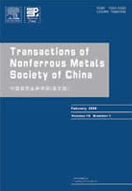Formation mechanism of bonded slag pellets in vertical-pot Pidgeon process of magnesium production
(1. School of Materials Science and Engineering, Zhengzhou University, Zhengzhou 450001, China;
2. College of Materials Engineering, Henan University of Engineering, Zhengzhou 451191, China;
3. Baosteel Metal Co., Ltd., China Baowu Steel Group Corporation, Shanghai 200940, China)
2. College of Materials Engineering, Henan University of Engineering, Zhengzhou 451191, China;
3. Baosteel Metal Co., Ltd., China Baowu Steel Group Corporation, Shanghai 200940, China)
Abstract: In the Pidgeon process involving a vertical pot, bonded slag pellets occasionally emerge at the bottom of the reduction pot, impeding smooth slag discharge. To reveal the formation mechanism of the bonded slag pellets, thermodynamic calculations, X-ray diffraction (XRD), X-ray fluorescence spectrometry (XRF), electron probe microanalyzer (EPMA), X-ray photoelectron spectroscopy (XPS), and differential scanning calorimetry (DSC) were employed. The bonded slag pellets mainly comprise MgO, CaSi2, CaO, and Ca2SiO4. CaSi2 in the bonded slag pellets is attributed to the reduction reaction between Si and CaO, yielding liquid CaSi2. Simultaneously, the reaction between CaSi2 and MgO, which will typically produce Mg vapor, is inhibited, resulting in the accumulation of CaSi2. Owing to the solid–liquid transition of CaSi2, this process culminates in the bonding of slag pellets. This study can guide the Pidgeon process optimization, enabling mitigation of the “dead pot” issue, thereby enhancing efficiency and reducing costs.
Key words: vertical-pot Pidgeon process; slag discharge; bonded slag pellets; CaSi2; solid-liquid transition

